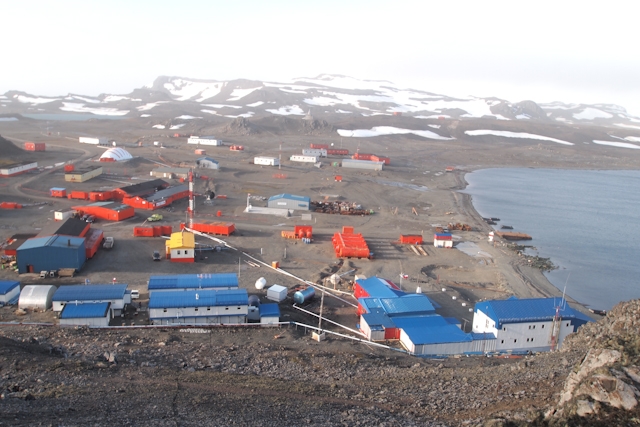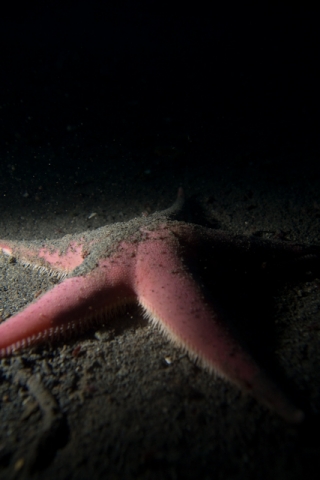What an experience living on King George Island has been. Isolated, often cloaked in mist, you definitely feel a long way from home. Yet the community and camaraderie that exists at the base makes one feel as if they are at a home away from home. The Chilean scientific research station Bescudero, where I’m based for the next three weeks, is basic yet comfortable with all the amenities one needs. The base comprises of a scientific and military compound, kept largely separate but in close quarters to one another. The scientific area has four main module buildings, two of which are sleeping quarters, a third housing the dry laboratory and communications, the fourth the eating quarters/kitchen/bedrooms. There are also a number of containers and other workshop areas scattered around the base. On the other side of the valley lies the Russian research station, it’s stark grey exterior and heavy ship like doors make it look more like a WWII outpost than research station, however it adds to aesthetics in an interesting way nonetheless.
Bescudero base.
Hoping into the back of a pick-up truck after landing on the island we were driven down a valley and into the base. Winding out way down the muddy dirt path, brown snow and old derelict trucks and diggers lay by the roadside, giving the island an almost ‘cold war Russia’ atmosphere at first impressions. This was soon to be shattered however when I donned my drysuit and dive gear and trekked down to the beach for our first dive. Chinstrap penguins squawked and awkwardly waddled towards the waters edge at the sight of the overloaded divers slowly approaching. Upon entering the water they move as if they truly came from the sea, moving with such speed and power they cut through the water as though they were flying in the sky above.
Boarding one of the many zodiacs that are available to the researching scientists we set out for a dive on one of the outlying islets near the base. Knowing it was my first dive the rest of the team was grinning from ear to ear knowing I would soon feel the icy touch of the water on my bare face for the first time! With the water temperature staying around 1ºC and occasionally dropping to 0ºC at the deeper depths this was by far the coldest diving I had ever done by a long shot. Norway in summer doesn’t come close!
Under the water the environment is truly remarkable, the visibility is good but not fantastic at around 10-15m. High levels of plankton and clouding from the floating icebergs cause the visibility to be less than what I thought it might be. However in winter the water is crystal. Large macro-algae dominate the benthic environment from zero to around 30-35m. All sorts of interesting sessile and motile invertebrates struggle to compete on the ocean floor, I quickly spy an urchin loosing the battle against an army of seastars, large golfball sponges in a huge range of colours are dotted around the crack and crevices, seemingly blind brittle stars stretch their spindly arms across the sand searching for their next meal, and an ice-fish lies on the bottom silently waiting for an unsuspecting prey to cross within striking distance. Excitingly, the biota gets really interesting at the deeper depths, diving beyond 30m the entire dynamic changes abruptly, you could almost draw a perfect line as to where the macro-algae stops and the wide and weird variety of gorgonians, sea fans, sea whips, and massive sponges begin. The true alien world of the Polar Regions begins down there!
I have been living on King George Island for just over a week as I write this. Time enough to learn the ways of life here and begin to settle into routine. Day to day living is no different from many scientific research stations par additional clothing! The reason that I am down here diving is to help Dr. Marcelo Gonzalez. Dr. Gonzalez’s studies focus on the induction of the immune response in the Antarctic sea urchin Sterechinus neumayeri by lipopolysaccharides and heat stress. By looking at the immune response of the Antarctic sea urchin (Sterechinus neumayeri) when it is exposed to increased seawater temperatures, we can determine the potential impacts that the global warming may have on the immune mechanisms of benthic invertebrates and their degree of susceptibility to pathogens. My major role in the study is collection the specimens as well as helping with the experiment in the laboratory, dissecting the urchins, fixing the oesophagus, axial organ (aids in drawing food into the urchins mouth) and epithelial linings for subsequent analysis.
During my time here I have also met Dr. Dirk Schories, a scientist whom is investigating Geo-referencing, biodiversity and growth rate in the southern oceans. Dirk has kindly allowed me to join his diving team, as without him I would have been a solo diver. Tagging along on dives with Dirk or one of the member of his team I have had the chance to not only collect Marcelo’s samples but see a great deal of the work that Dirk is undertaking as well. Also I have been given a chance to snap some pictures and record some footage in the icy waters!
I will continue to dive on a daily basis for the next two weeks as long as the weather lets me! We also have some exciting day trips planned for sampling near the northern glacier on the island and taking a visit to the Elephant Seal colony on the northern side of the island! I’ll be sure to let you know how it all goes.




























